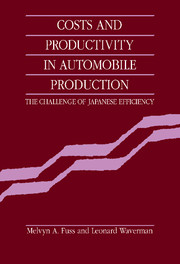Book contents
- Frontmatter
- Contents
- Preface
- Chapter 1 Introduction
- Chapter 2 International differences in output, productivity, and wages in the automobile industry: the 1950s to the mid-1980s
- Chapter 3 The cost-function approach to the analysis of cost and total factor productivity differences
- Chapter 4 Data base sources and method of construction
- Chapter 5 Empirical results: estimation of the cost function
- Chapter 6 Productivity growth in the automobile industry, 1970–1984: a comparison of the United States, Japan, Germany, and Canada
- Chapter 7 International comparisons of automobile industry cost and productivity levels: Japan, Germany, and the United States
- Chapter 8 International comparisons of automobile industry cost and productivity levels: Canadian with U.S., Japanese, and German production
- Chapter 9 Summary and conclusions
- References
- Index
Chapter 2 - International differences in output, productivity, and wages in the automobile industry: the 1950s to the mid-1980s
Published online by Cambridge University Press: 16 October 2009
- Frontmatter
- Contents
- Preface
- Chapter 1 Introduction
- Chapter 2 International differences in output, productivity, and wages in the automobile industry: the 1950s to the mid-1980s
- Chapter 3 The cost-function approach to the analysis of cost and total factor productivity differences
- Chapter 4 Data base sources and method of construction
- Chapter 5 Empirical results: estimation of the cost function
- Chapter 6 Productivity growth in the automobile industry, 1970–1984: a comparison of the United States, Japan, Germany, and Canada
- Chapter 7 International comparisons of automobile industry cost and productivity levels: Japan, Germany, and the United States
- Chapter 8 International comparisons of automobile industry cost and productivity levels: Canadian with U.S., Japanese, and German production
- Chapter 9 Summary and conclusions
- References
- Index
Summary
We begin with a brief overview of the automobile industries of the four countries under study. The purpose of this examination is to provide a context for analyzing productivity developments by examining production, imports, exports, changes in the uses of factors, and factor prices (Sections 2.1–2.3); to provide simple comparisons of productivity (Section 2.4), and to examine the productivity calculations made by others (Sections 2.5–2.8).
Imports, exports, and trade restraints
In Tables 2.1–2.4 we provide data on domestic production, imports, exports, and registration of automobiles in each of the four countries. Before discussing the production numbers, it is useful to examine the trade restraints operative in each country over the period 1961 to 1984. The U.S. auto industry did not have extensive protection against foreign suppliers until the 1981 Voluntary Restraint Agreements (VRA) were agreed to by the Japanese exporters. In 1970, the U.S. tariff was 4.5% on passenger cars and 8.5% on light trucks; no other trade restrictions existed. In 1973, just after the Kennedy Round of GATT (General Agreement on Tariffs and Trade), the tariff on passenger cars was cut to 3%. Despite the absence of substantial trade restrictions, imports were not significant in the United States until 1959, when they peaked at 9% of U.S. auto sales. Imports then fell until 1966, whereafter they rose again to 8% of U.S. sales. Part of this increase was due to the 1965 Auto Pact liberalizing trade between Canada and the United States.
Information
- Type
- Chapter
- Information
- Costs and Productivity in Automobile ProductionThe Challenge of Japanese Efficiency, pp. 17 - 63Publisher: Cambridge University PressPrint publication year: 1992
